Family : Lutjanidae

Text © Giuseppe Mazza

English translation by Mario Beltramini
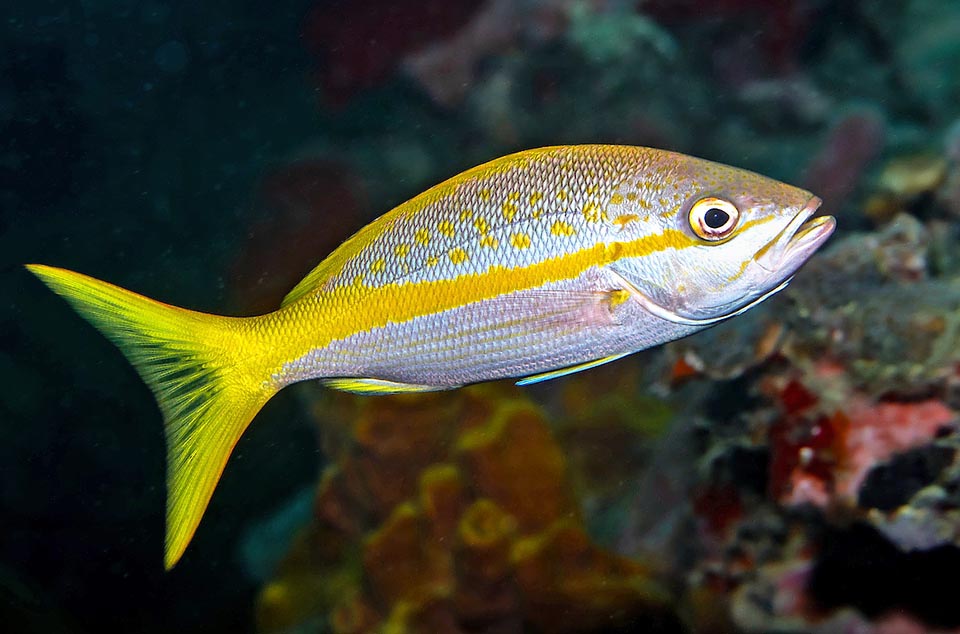
About 40 cm long, 86,3 cm at most and 4,1 kg, Ocyurus chrysurus is frequent from Massachusetts and Brazilian coasts, up to São Paulo coasts © Allison & Carlos Estape
The Yellowtail snapper, Ocyurus chrysurus (Bloch, 1791), belongs to the class of the Actinopterygii, the ray-finned fishes, to the great order of the Perciformes, rich in over 7000 species, and to the family of the Lutjanidae, present in the tropical and subtropical seas of the whole world with 17 genera and 113 species.
They are the so-called spanning fishes due to that voracity comparable to that of the true dentexes, such as Dentex dentex who are however taxonomically assigned to the family of the Sparidae.
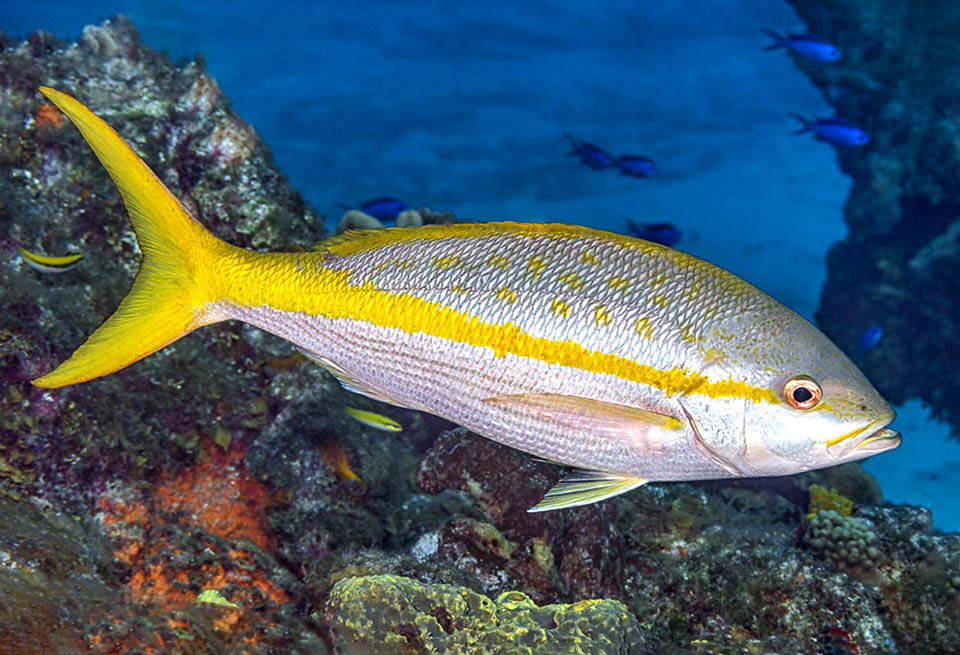
In the adults the caudal fin, very biforked, is longer on the upper lobe. The livery is divided in two horizontally by a yellow band © François Libert
Due to the behaviour, the appearance and the nutritional interest they are however very similar fishes, in fact the species was described by Bloch in 1791 as Sparus chrysurus and later as Sparus semiluna by Lacepède in 1802, and both families belong to the suborder of the Percoidei.
The genus Ocyurus originates with reference to the forked tail of the Pallid swifts, like Apus pallidus, from the Greek “ocy”, swift and “oura”, tail; whilst the specific term chrysurus specifies that its caudal fin, deeply forked, is yellow, from the Greek “chryso”, gold and “oura”, tail.
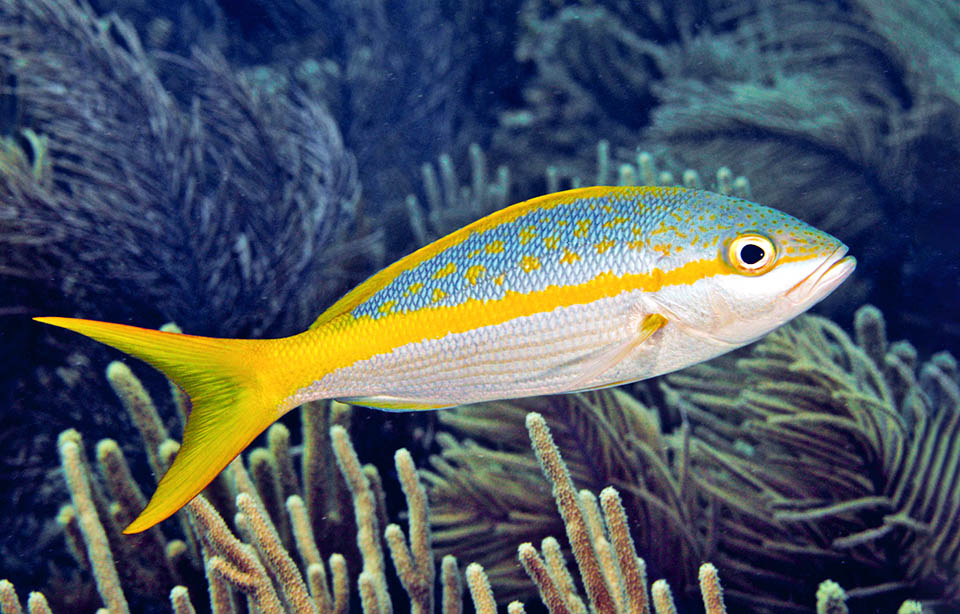
The often bluish upper part is dotted by yellow spots whilst the ventral is silvery with alternate reddish and yellow thin lines © Allison & Carlos Estape
Zoogeography
Quite common in the Bahamas, Ocyurus chrysurus is present in the west Atlantic from Massachusetts and Bermudas to the Gulf of Mexico, the Caribbean Sea and then, southward, in Brazil, up to the coasts of the State of São Paulo.
Perhaps thanks to the larvae carried by the currents, it has been finally reported in the east Atlantic along the coasts of the Cape Verde islands.
Ecology-Habitat
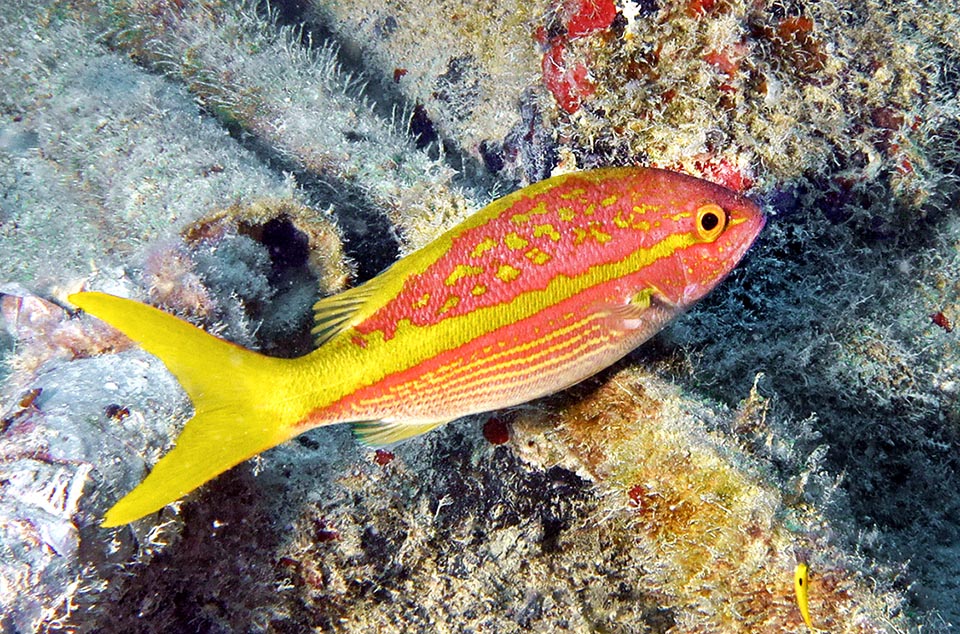
Here they are well visible and on top the background colour may be even violet or red © www.MBARA.org
The Yellowtail snapper usually swims over the madreporic formations between 10 and 70 m of depth, but can be found even in shallower waters and up to about 180 m, solitary or in small schools, often associated with other
Lutjanidae and even a Yellow goatfish, Mulloidichthys martinicus, who assumes its colours camouflaging itself inside the school.
The adults usually frequent the same zone for long periods.
The juveniles, often in small schools, grow hidden in the prairies of seagrass but may be found also in shallow waters on the rocky seabeds.
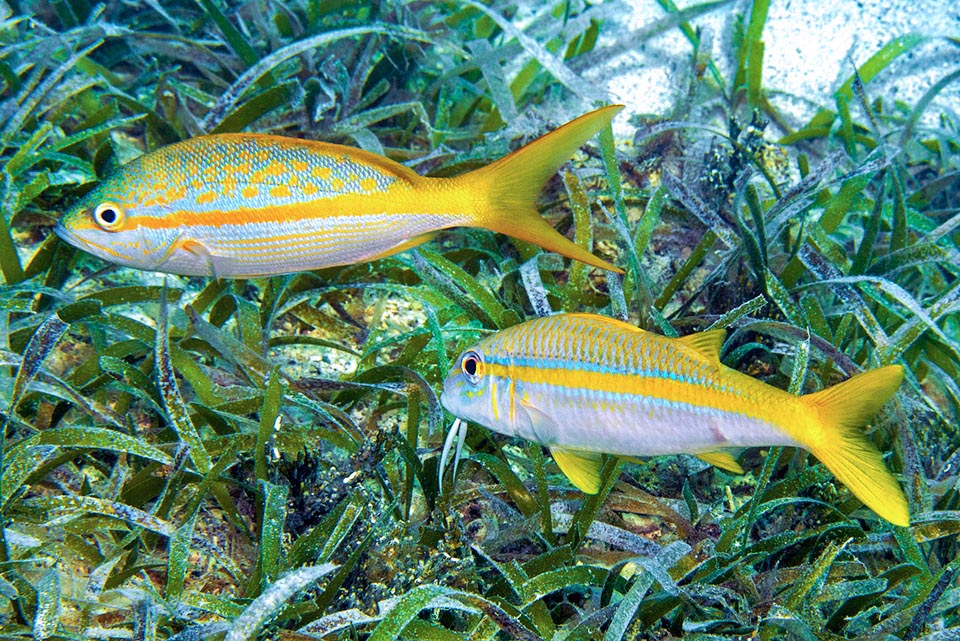
It moves alone or in schools, often associated to other species such as this goatfish (Mulloidichthys martinicus) who imitates its colour to go unnoticed © Allison & Carlos Estape
Morphophysiology
Ocyurus chrysurus can reach the length of 86,3 cm with a maximum published weight of 4,1 kg, but the current size is around 40 cm. The body is elongated with a pointed head and a symmetrical profile.
The front and back nostrils are two simple holes placed on both sides of the snout. The preoperculum has a serrated edge with toothed lower margin.
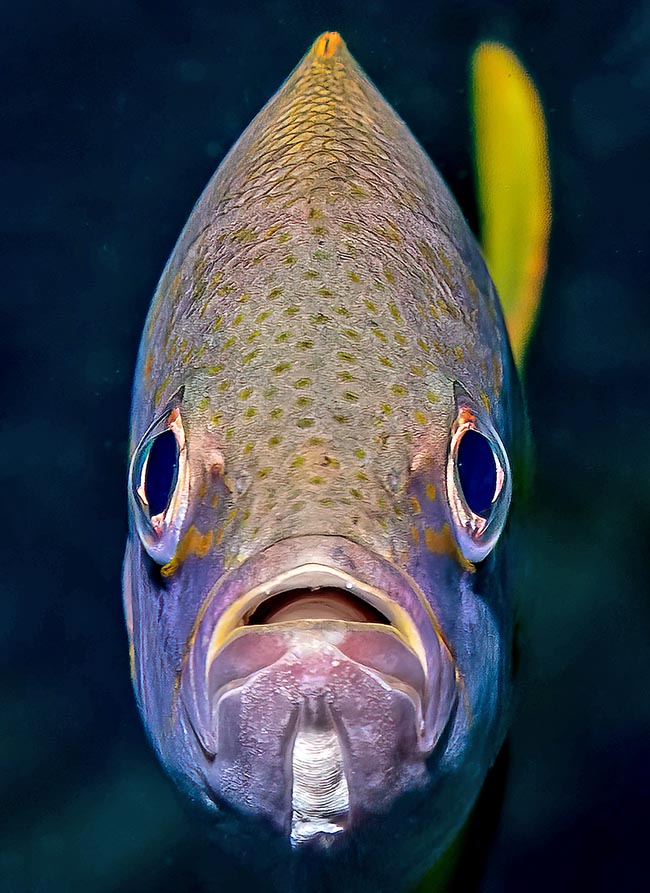
The mouth of Ocyurus chrysurus is relatively big with the upper jaw moderately protractile. The teeth, conical and pointed with some front canine, are present in one or more rows on both jaws and in the mouth on vomer and sides © Allison & Carlos Estape
The zone under the eye and the jaws are scaleless, that are insead present on the cheeks and the operculum including the base of the dorsal and the anal fins. They overlap parallel on the sides of the body and diagonally over the lateral line.
The mouth is rather big with the upper jaw, moderately protractile, that slides closing under the cheekbone for a good part of its length.
The teeth, conical and pointed, with some front canine, are present in one or more rows on both jaws.
Others stand on the vomer forming, approached like in other Lutjanidae, a patch of spikes arranged, shaped like an anchor, with thin and elongated spindle. Finally, at the top of the mouth, stands a plate of palatine teeth per side.
The dorsal fin has 10 spiny rays and 12-14 soft; the anal 3 spiny rays and 8-9 unarmed.
The pectoral fins, pointed and unarmed like the pelvic ones, count 15-16 rays.
The caudal, emarginate in the juveniles, is deeply forked in the adults with very long lobes in the large fishes who have the upper one longer.
The livery is characterized by a bright yellow horizontal band that divides the fish in two parts. Crossing the eye, it goes from the tip of the snout up to the caudal peduncle where it gets wider colouring also the fins.
The part over this band is dotted with yellow spots on a silvery grey, blue, violaceous or pinkish background.
Below, the fish is silvery with thin reddish and yellow bands, alternate and often hardly visible. The dorsal fin is always yellow, the anal is less intensely coloured or tending white like the pelvic and the long translucent pectoral fins. Also in the juveniles is present the yellow stripe, that initially starts after the eye reaching the caudal peduncle.
Ethology-Reproductive Biology
The young Ocyurus chrysurus mainly feed on plankton.
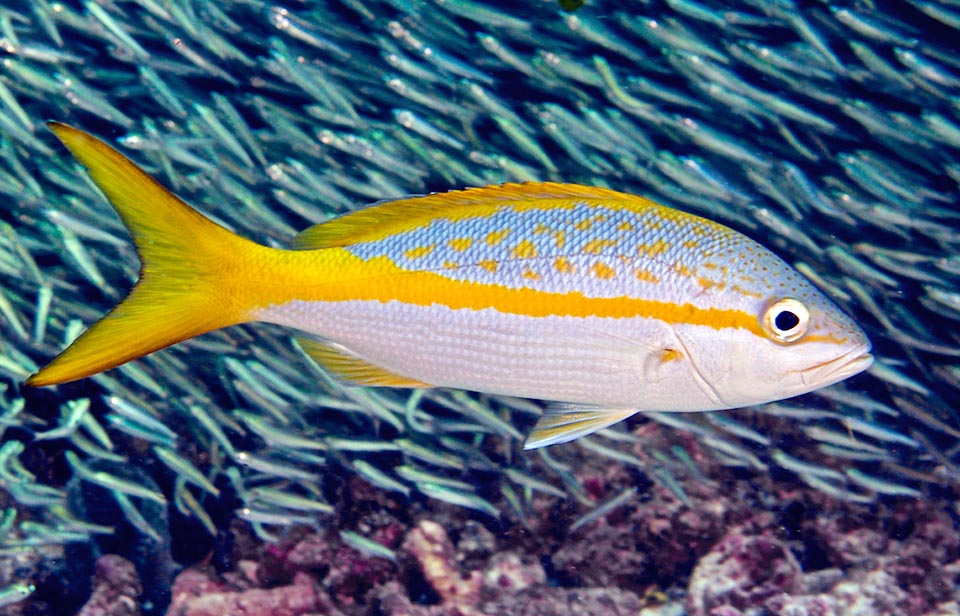
In youth Ocyurus chrysurus eats plankton and later, increasingly, fishes, crustaceans, worms, gastropods and cephalopods © Allison & Carlos Estape
Moreover, the adults prey, especially by night, fishes, crustaceans, worms, gastropods and cephalopods.
The Yellowtail snapper reaches its sexual maturity during the second year of life when about 20-30 cm long with a maximum longevity of 17-19 years.
The reproduction can take place at any moment but with different peaks depending on the locations. In Cuba, the depositions occur mainly in April and later, to a lesser extent, in September; in Brazil between September and October and then in February-March.
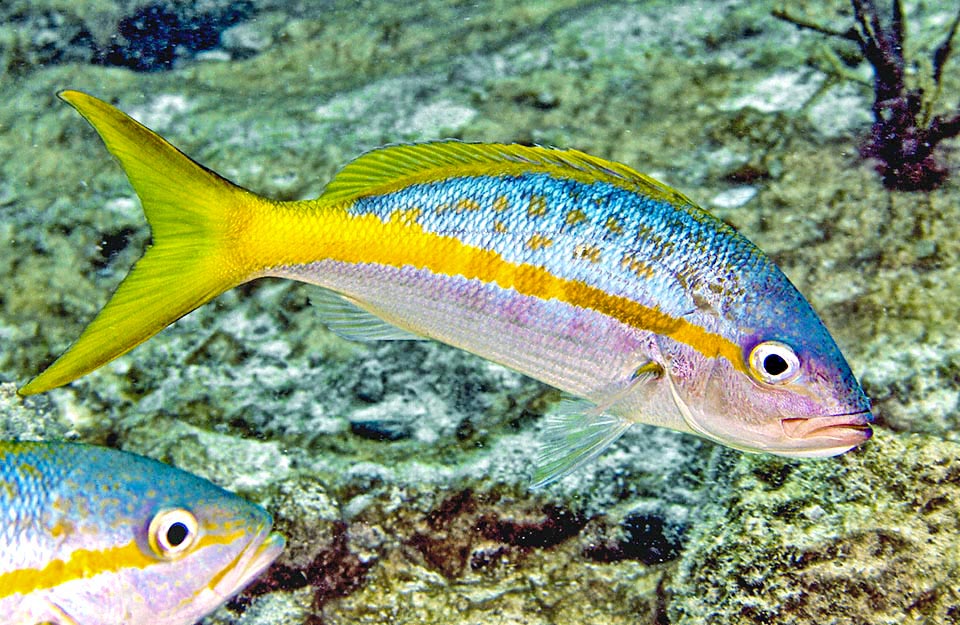
It reproduces all the year with different peaks depending on the sites. The eggs are entrusted to the currents and hatch after 24 hours © Allison & Carlos Estape
The fecundated eggs are entrusted to the currents and hatch quickly after about 24 hours.
The flesh of Ocyurus chrysurus is excellent and is fished for pleasure by the tourists and professionally with traps, longlines and nets. Throughout its range is a species very important for human nutrition and some farms have sprung up.
Looking at the last few years the fishing in Florida is regulated at about 700 tons per year, Mexico does the same and in Cuba the average catch is about 500 tons.
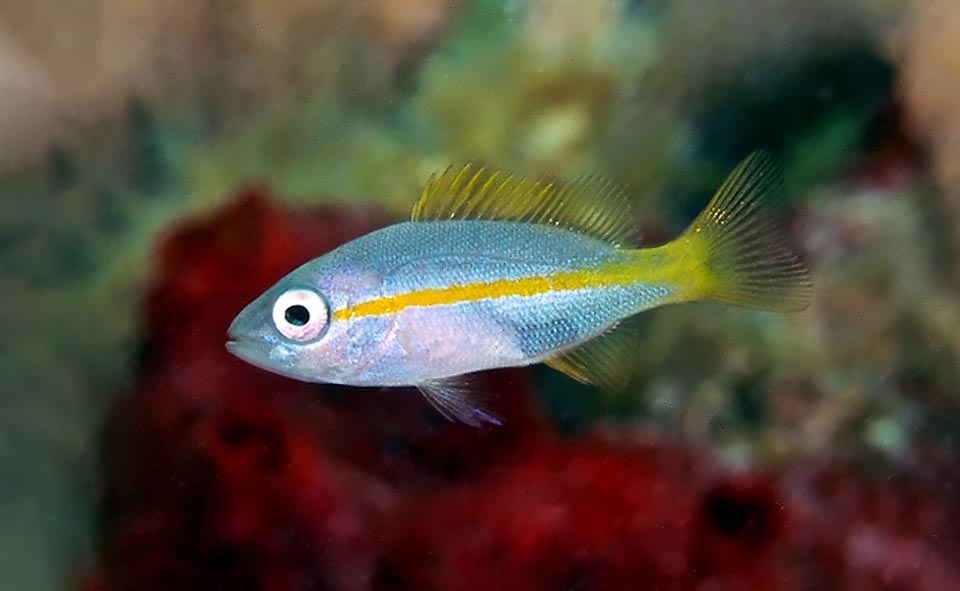
A Juvenile still with the emarginate tail. If not fished, will mature when about 2 years old with a life expectancy of 17-19, but the trend of populations is unknown© Allison & Carlos Estape
Brazil is the main exporter of this species worldwide, though, like all Caribbean predators, its flesh is at ciguatera risk, a severe food poisoning theoretically possible if they have preyed upon animals who store in their tissues the toxin produced by the dinoflagellate Gambierdiscus toxicus.
The resilience of the species is mediocre, with a minimum time for the doubling of the populations of 1,4-4,4 years, and globally the fishing vulnerability is moderate marking 38 on a scale of 100, but there is no precise data about the trend of the populations.
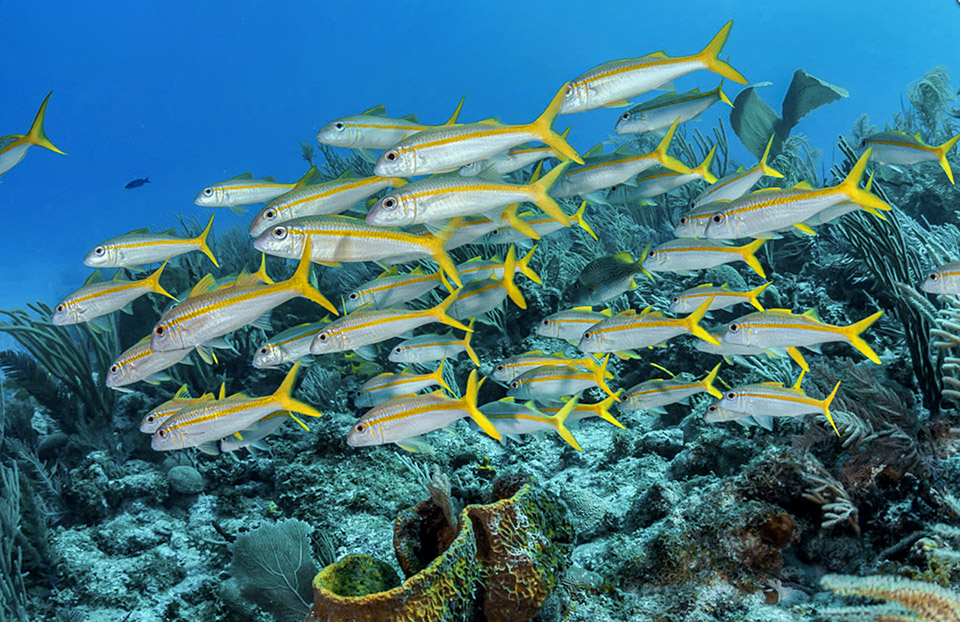
The IUCN Red List of the endangered species therefore doesn’t opine due to lack of data. Here subadults mixed with Mulloidichthys martinicus goatfish © Wolfram Sander
Consequently, Ocyurus chrysurus appears from 2015 as “DD, Data deficient”, in the IUCN Red List of the endangered species.
Synonyms
Sparus chrysurus Bloch, 1791; Lutjanus chrysurus (Bloch, 1791); Mesoprion chrysurus (Bloch, 1791); Anthias rabirrubia Bloch & Schneider, 1801; Sparus semiluna Lacepède, 1802; Mesoprion aurovittatus Agassiz, 1831; Ocyurus aurovittatus (Agassiz, 1831); Ocyurus rijgersmaei Cope, 1871.
→ For general information about FISH please click here.
→ For general information about BONY FISH please click here
→ For general information about CARTILAGINOUS FISH please click here.
→ To appreciate the BIODIVERSITY of BONY FISH please click here.
→ To appreciate the BIODIVERSITY of CARTILAGINOUS FISH please click here.
